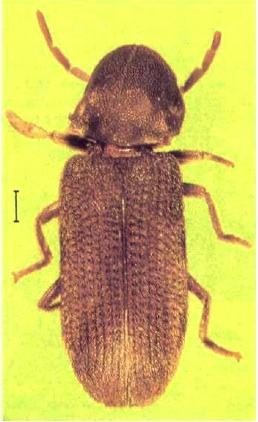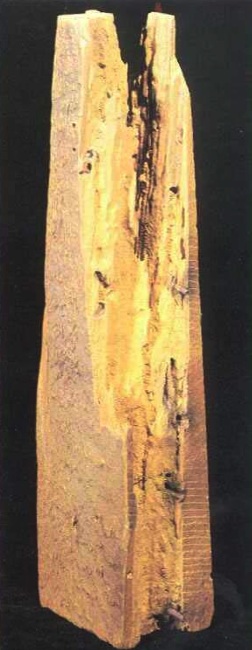PESTS AND DISEASES OF FORESTRY IN NEW ZEALAND
Hadrobregmus magnus
Scion is the leading provider of forest-related knowledge in New Zealand
Formerly known as the Forest Research Institute, Scion has been a leader in research relating to forest health for over 50 years. The Rotorua-based Crown Research Institute continues to provide science that will protect all forests from damage caused by insect pests, pathogens and weeds. The information presented below arises from these research activities.
Forest and Timber Insects in New Zealand No. 1.
Revised 2009
Based on G.P. Hosking (1976).
Insect: Hadrobregmus magnus (Dumbleton)* (Coleoptera: Anobiidae)
*Formerly known as Anobium magnum Dumbleton

Fig. 1 - Hadrobregmus magnus adult.
Related species
There is a second species of Hadrobregmus, H. australiensis Pic., from Australia, which has been established in New Zealand for many years. It is widely distributed and has similar habits to the native H. magnus. The adult is distinguished by the coarser, rectangular, punctations on the elytra, and the absence of the small notch in the dorsal posterior margin of the prothorax which occurs on H. magnus.
Type of injury
Larval tunnels of Hadrobregmus magnus are round in cross-section, generally parallel with the grain of the wood, and often coalesce to form irregular chambers. The galleries are loosely packed with fine gritty frass which may also spill from exit holes made by the emerging adults. Exit holes are round and between 2.5 mm and 3.0 mm in diameter. The pupal chamber situated just below the surface is slightly greater in diameter than the exit hole.
Hosts
This forest insect has been recorded from dead Dacrydium cupressinurn (rimu), Podocarpus totara (totara), Neopanax, Cytisus proliferus (tree lucerne), Eucalyptus delegatensis, Cupressus macrocarpa, Picea abies (Norway spruce), Pinus radiata (radiata pine), and Pseudotsuga menziesii (Douglas fir). Attack on sawn timber is known mainly in rimu and totara under damp conditions. Both sapwood and heartwood are affected.
H. australiensis has been recorded from Eucalyptus spp. and Metrosideros excelsa (pohutukawa).
Distribution
This insect is native to New Zealand and is present throughout the country.
Economic importance
Hadrobregmus magnus may cause severe structural damage to rimu flooring and subflooring where ventilation is inadequate as moist, dark situations are apparently preferred. The infested timbers may be reduced to a thin shell (Fig. 2). It is far less common in timbers in use than the household borer, Anobium punctatum.

Fig. 2 - Rimu timber damaged by larvae of Hadrobregmus magnus
Description, life history, and habits
The adult is dark brown and has an almost cylindrical body. When the beetle is seen from above, the head is completely hidden by the pronotum. The elytra (wing cases), which bear longitudinal rows of punctures, are parallel-sided and rounded at the rear. Adults are 6-8 mm long and 2.5-3.0 mm wide (Fig.1).
The larvae are C-shaped and white. They have three pairs of short legs, a yellowish head, and black jaws. Bands of small spines are present on top of the rear thoracic segment and all ten abdominal segments. Xyletinus undulatus, another anobiid borer, also has small spines on the last abdominal segment but the fully grown larva is much smaller than that of H. magnus. The larva of the household borer, A. punctatum, is similar in size to that of X. undulatus but lacks spines on the last three abdominal segments.
There is little published information on the habits of H. magnus. Forest Research Institute records suggest that successful attack depends on prior invasion of the wood-rotting fungi although larval workings may extend into sound wood. Alternatively, those conditions favourable for H. magnus are coincidently favourable for wood-rotting fungi. The length of the life cycle is not known. Pupation occurs just under the wood surface or beneath bark and adults are known to emerge during May, June, and July.
Control
Heavy infestations will probably require replacement of affected building timbers, and repairs or alterations to ensure that other untreated timbers remain dry. Pretreatment of timber with preservatives gives complete protection.
Bibliography
Dumbleton, L.J. 1941: Anobium magnum (Coleoptera: Anobiidae): a new borer. New Zealand Journal of Science and Technology 22b (6): 294-299.
Hosking, G.P. 1976: Hadrobregmus magnus (Dumbleton) (Coleoptera: Anobiidae). New Zealand Forest Service, Forest and Timber Insects in New Zealand No. 1.
This information is intended for general interest only. It is not intended to be a substitute for specific specialist advice on any matter and should not be relied on for that purpose. Scion will not be liable for any direct, indirect, incidental, special, consequential or exemplary damages, loss of profits, or any other intangible losses that result from using the information provided on this site.
(Scion is the trading name of the New Zealand Forest Research Institute Limited.)

 Farm Forestry New Zealand
Farm Forestry New Zealand

